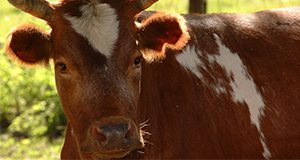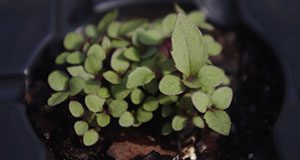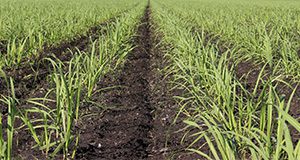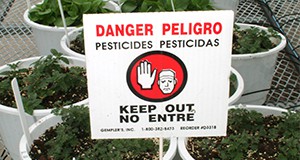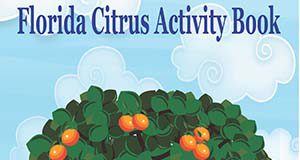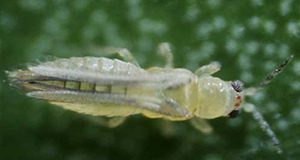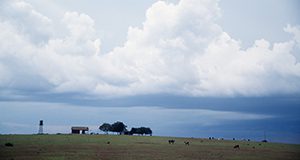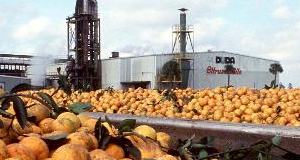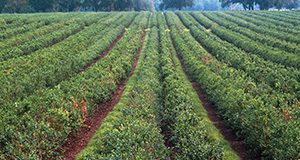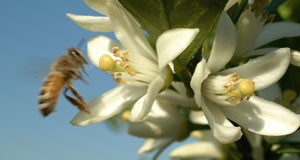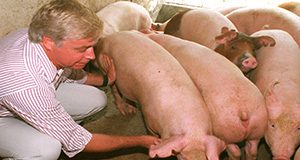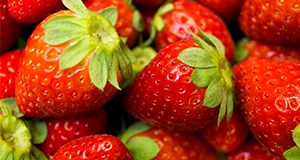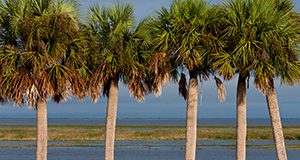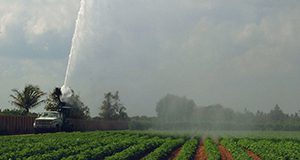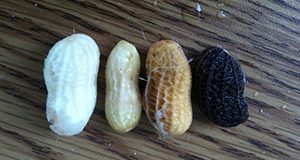The 16th annual Florida Bull Test Sale was held on January 16, 2016 at the conclusion of the 2015–2016 Florida Bull Test. The test evaluated the performance potential and breeding soundness of bulls consigned to the program at the UF/IFAS North Florida Research and Education Center (NFREC). This 10-page fact sheet covers the test procedures, assessment of feed efficiency, general policies and procedures, health requirements, test results, and sale summary. Written by Carla D. Sanford, G. Cliff Lamb, and Nicolas DiLorenzo, and published by the UF Department of Animal Sciences, November 2016.
http://edis.ifas.ufl.edu/an328
Category: Agriculture
Biology and Management of Thickhead (Crassocephalum crepidioides) in Ornamental Crop Production
Typically found in shadehouses and shaded areas of nursery production, thickhead grows aggressively in containers and can outcompete nursery crops for water, nutrients, and light. This erect, sparingly branched, herbaceous annual, grows up to 4 feet tall and germinates over a wide range of pH, salt, and temperature conditions. This four-page fact sheet describes thickhead (Crassocephalum crepidioides) and various methods for its control in ornamental crop production. Written by Allison Bechtloff, Shawn Steed, Chris Marble, and Nathan Boyd and published by the Environmental Horticulture Department.
http://edis.ifas.ufl.edu/ep534
Sugarcane Cultivars Descriptive Fact Sheet: CP 96-1252, CP 01-1372, and CP 00-1101
Sugarcane cultivars CP 96-1252, CP 01-1372, and CP 00-1101 are the top three commercial sugarcane cultivars in Florida, occupying more than 43% of total sugarcane area. These cultivars are developed through the cooperative agreement among the United States Department of Agriculture (USDA), Canal Point, the UF/IFAS Everglades Research and Education Center in Belle Glade, and the Florida Sugar Cane League. This 4-page fact sheet provides information on the cultivars, their parentage, flowering, cold tolerance, yields, disease response, and major growth or yield issues. Written by Hardev Sandhu and Wayne Davidson, and published by the UF Agronomy Department, December 2016.
http://edis.ifas.ufl.edu/sc102
Quick Reference Guide to the Worker Protection Standard (WPS) as Revised in 2015
The Worker Protection Standard (WPS) is a regulation originally issued by the US Environmental Protection Agency (EPA) in 1992 and most recently revised in 2015. This eight-page reference guide gives an overview of the 2015 revisions. Written by Frederick M. Fishel, and published by the Agronomy Department.
http://edis.ifas.ufl.edu/pi270
Florida Citrus Activity Book
The Florida Citrus Activity Book is a basic introduction to Florida citrus trees, diseases, and pests. This 20-page booklet is for elementary students. Written by J.D. Burrow, M.M. Dewdney, M.E. Rogers, and T. Vashisth and published by the Plant Pathology Department.
http://edis.ifas.ufl.edu/pp331
Thrips Management Program for Horticultural Crops
Among the 5,500 (or more) well-described species of thrips worldwide, nearly 1% are known as economically important pests. Because these tiny pests can feed on multiple plants, their damage potential to nursery and greenhouse production is immense: thrips inflict millions of dollars loss every year. Thrips hide easily in tiny spaces, reproduce rapidly, and can survive in lots of climates. And they are invisibly small! Thrips infestations present a huge problem in the regional and international trade of plant materials and products, due to the quarantine risks and damage associated with several species in the order.
This 7-page fact sheet written by Vivek Kumar, Garima Kakkar, Cristi Palmer, Cindy L. McKenzie, and Lance S. Osborne and published by the UF Department of Entomology and Nematology presents a program to manage important thrips pests, including western flower thrips (Frankliniella occidentalis), chilli thrips (Scirtothrips dorsalis), weeping fig thrips (Gynaikothrips uzeli), gladiolus thrips (Thrips simplex), and privet thrips (Dendrothrips ornatus) known to damage several horticultural crops of economic importance in the United States. The publication will help growers take appropriate measures to minimize economic damage.
http://edis.ifas.ufl.edu/in1145
Improving, Restoring, and Managing Natural Resources on Rural Properties in Florida: Sources of Financial Assistance
Interested in conserving natural resources, such as wildlife habitat, or protecting the agricultural heritage of your land? Both federal and state governments have technical and financial assistance programs to help rural landowners achieve natural resource goals. These challenges are addressed through land rentals, technical assistance, cost-shares, and incentive payments and include both time-limited and permanent land-use options.
This 8-page fact sheet written by Chris Demers, Martin B. Main and Mark E. Hostetler and published by the UF School of Forest Resources and Conservation informs landowners about government programs available to help conserve natural resources.
http://edis.ifas.ufl.edu/fr156
Harvesting Charges for Florida Citrus: Picking, Roadsiding, and Hauling, 2015/16
A survey of Florida citrus harvesters was conducted in July 2016 to collect data and estimate the harvesting charges to Florida citrus growers during the 2015/16 season. This 5-page fact sheet written by Ariel Singermam, Marina Burani-Arouca, and Stephen H. Futch and published by the UF Department of Food and Resource Economics presents the results of the survey, summarizing the harvesting charges for citrus during the 2015/16 season and documenting the changes in harvesting costs as the impact of HLB increases across the state. The estimates presented provide the basis for computing on-tree prices from delivered-in prices, thus allowing the computation of the change in citrus growers’ economic returns as the industry adapts to remain profitable.
http://edis.ifas.ufl.edu/fe1005
Establishment and Production Costs for Southern Highbush Blueberry Orchards in Florida: Enterprise Budget and Profitability Analysis
The United States is the world’s largest producer of blueberries. Florida’s blueberry production represents a small fraction of total US production, but blueberries are nevertheless an important and valuable crop in the state because Florida growers benefit from the nation’s earliest market window. In fact, the average price for blueberries received by growers in Florida during the last three years was 2.5 times the US average.
This 15-page fact sheet written by Ariel Singerman, Marina Burani-Arouca, Jeffrey G. Williamson, and Gary K. England, and published by the UF Department of Food and Resource Economics provides a summary of the enterprise budget developed for highbush blueberry production in Florida. The budget represents a typical operation and serves as an economic benchmark for growers, providing estimates of expenses and potential estimates of revenue and profit for a blueberry crop to help current and potential blueberry growers make informed decisions about blueberry production.
http://edis.ifas.ufl.edu/fe1002
Keeping Bees in Florida
As of June 2016, there are over 4,000 registered beekeepers in the state of Florida and 440,000 managed colonies. According to the USDA, 2012 Florida beekeepers produced over 11 million pounds of honey. The average winter colony loss in Florida as reported by the Bee Informed Partnership Management Survey was the third lowest rate across the nation with only Hawaii and Texas reporting lower colony losses in that time period. This 4-page fact sheet written by Tomas A. Bustamante, Jamie D. Ellis, and Mary Bammer and published by the UF Department of Entomology and Nematology gives an overview of what makes Florida a unique state in which to keep honey bees. It explains the ins and outs of beekeeping in Florida, with descriptions of some of the hazards, a few of the important nectar-producing plants, special considerations for seasonal colony growth and management, and Florida beekeeping regulations.
http://edis.ifas.ufl.edu/aa264
Chalkbrood Recommendations
A pathogenic fungus called chalkbrood can turn infected larval honey bees into “mummies,” killing them and reducing their colony’s population and productivity. Florida’s subtropical climate may contribute to a greater incidence of the disease, which is common throughout the state. This 2-page fact sheet describing chalkbrood and listing some management strategies to control it was written by Malcolm T. Sanford, Cameron J. Jack, and Jamie Ellis, and published by the UF Department of Entomology and Nematology, December 2016.
http://edis.ifas.ufl.edu/aa138
The Food Safety Modernization Act (FSMA) Preventive Controls for Animal Food
The Food Safety Modernization Act (FSMA) was signed into law in January of 2011 and is considered the most sweeping reform of food safety regulations in 70 years. The human food regulations were composed first and, with significant input from industry, academia, and consumer groups as well as other agencies, were then modified to better suit animal food production. In Florida, these new regulations apply to facilities that manufacture, process, pack, or hold food or food ingredients for animals. These facilities may include pet food manufacturers, renderers, ethanol distillers, feed mills, distributors, and others. The primary goal of these regulations is to ensure safe food for the animals, people who handle the feed, and people who consume the final animal products. This 3-page fact sheet discusses requirements, facilities that will most likely be expected to be in compliance, deadlines, development of a food safety plan, and preventive controls qualified individuals. Written by Jason M. Scheffler and Chad Carr, and published by the UF Department of Animal Sciences, December 2016.
http://edis.ifas.ufl.edu/an330
DNA, Technology, and Florida Strawberries
Are Florida strawberries genetically engineered? The answer is no. No genetically engineered strawberry has been commercialized anywhere in the world. The UF/IFAS strawberry breeding program has been developing strawberry varieties for nearly 70 years, but these varieties are developed using a conventional breeding process of crossing and selection. This three-page fact sheet describes that process in greater detail. Written by Seonghee Lee, Young-Hee Noh, Sujeet Verma, and Vance M. Whitaker and published by the Horticultural Sciences Department.
http://edis.ifas.ufl.edu/hs1287
Also see the UF/IFAS press release (12/14): UF/IFAS scientists: Commercially grown strawberries are not genetically engineered
Biology and Management of Pilea microphylla(Artillery weed) in Ornamental Crop Production
This five-page fact sheet describes the biology and management of Pilea microphylla, or artillery weed, for ornamental crop production. Artillery weed occurs primarily in moist, disturbed areas and is thought to be native to South America and parts of North America. It is found throughout Florida. Written by Debalina Saha, Chris Marble, Shawn Steed, and Nathan Boyd and published by the Environmental Horticulture Department.
http://edis.ifas.ufl.edu/ep535
Fertilization of Field-Grown and Landscape Palms in Florida
Palms growing in Florida landscape or field nurseries are subject to a number of potentially serious nutrient deficiencies. This five-page document discusses the prevention and treatment of these deficiencies. Written by Timothy K. Broschat and published by the Environmental Horticulture Department.
http://edis.ifas.ufl.edu/ep261
What the 2012 Census of Agriculture Is Telling Us about Miami-Dade County
Agriculture is an important contributor to Florida’s economy. Only the tourism industry employs more Floridians. In 2012, agricultural output was estimated at $141.8 billion, accounting for 14.9% of the state’s gross domestic product, and providing employment for 20.8% of the state’s labor force. Monitoring the performance of the sector over time is therefore of critical importance to various stakeholders. This 8-page publication written by Edward Evans and published by the Food and Resource Economics Department focuses on the Agricultural Census data for Miami-Dade County and specifically examines trends over the 15-year period from 1997 to 2012 with the aim of highlighting some of the major trends occurring in the Miami-Dade County agricultural sector. In general, the data show that in spite of challenging times, the agricultural industry has remained important, contributing $604 million to the Florida economy in 2012.
http://edis.ifas.ufl.edu/fe1001
Pre-Breeding Considerations for the Development of Replacement Beef Heifers
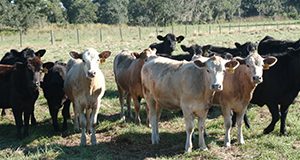 The efficiency of post-weaning development of heifers has a major impact on the overall profitability of cow-calf operations. To ensure satisfactory performance during the first breeding season, replacement heifers must be subjected to an adequate development program. This 3-page fact sheet covers age at puberty, nutrition, target body weight gain, pelvic area measurements, reproductive tract score, and herd health. Written by Pedro L. P. Fontes, Nicky Oosthuizen, Carla D. Sanford, and G. Cliff Lamb, and published by the UF Department of Animal Sciences, November 2016.
The efficiency of post-weaning development of heifers has a major impact on the overall profitability of cow-calf operations. To ensure satisfactory performance during the first breeding season, replacement heifers must be subjected to an adequate development program. This 3-page fact sheet covers age at puberty, nutrition, target body weight gain, pelvic area measurements, reproductive tract score, and herd health. Written by Pedro L. P. Fontes, Nicky Oosthuizen, Carla D. Sanford, and G. Cliff Lamb, and published by the UF Department of Animal Sciences, November 2016.
http://edis.ifas.ufl.edu/an329
University of Florida Potato Variety Spotlight: Snowden
This five-page fact sheet describes a new University of Florida potato variety named Snowden. ‘Snowden’ is a potato variety that is commonly grown for the potato chip market. It was named and released in 1990 from the University of Wisconsin’s Lelah Starks Potato Breeding Farm in Rhinelander, WI. Tuber production and quality results provided in this spotlight are summarized from various variety trials conducted by the University of Florida’s Hastings Agricultural and Extension Center from 1998 to 2015. Written by Rodrick Z. Mwatuwa, Christian T. Christensen, and Lincoln Zotarelli and published by the Horticultural Sciences Department.
http://edis.ifas.ufl.edu/hs1286
Herbicidas Postemergentes para Uso en Ornamentales

This is the Spanish language version of ENH95/WG095 Postemergent Herbicides for Use in Ornamentals http://edis.ifas.ufl.edu/wg059 Postemergent herbicides are applied directly to weeds. This 5-page fact sheet is largely comprised of two tables: Table one lists postemergent herbicides that can be safely used over the top of some ornamentals when used according to label directions; table 2 lists postemergent herbicides that are registered for use around ornamental plants when applied as a directed spray. Written by E. Vanesssa Campoverde, Chris Marble, and Jeffrey G. Norcini and published by the Environmental Horticulture Department.
http://edis.ifas.ufl.edu/ep533
Methods to Evaluate Peanut Maturity for Optimal Seed Quality and Yield
Determining when to dig is one of the most important economic decisions a grower must make. Peanut (Arachis hypogaea L.) poses a unique challenge for maturity determination because it is an indeterminate crop that forms pods underground. This 8-page fact sheet discusses maturity assessment methods as well as steps for collecting and evaluating a maturity sample. Written by Ethan Carter, Patrick Troy, Diane Rowland, Barry Tillman, Keith Wynn, Krystel Pierre, and Michael Mulvaney, and published by the UF Agronomy Department, September 2016.
http://edis.ifas.ufl.edu/ag411
